Refining the Plateau
Posted by Stuart Staniford on January 5, 2006 - 7:07am
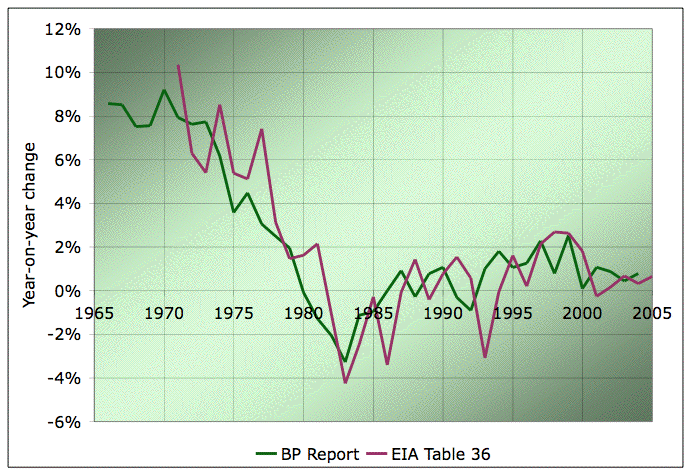
Year-on-year change in refinery capacity 1965-2005 by two different estimates. Click to enlarge. Sources: BP Statistical Review of World Energy 2005, and EIA Crude Oil Distillation Capacity (Table 36).
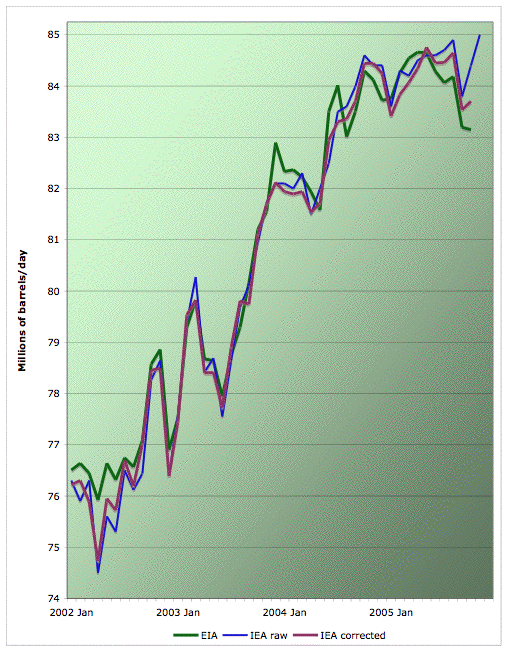
Average monthly oil production from various estimates. Click to enlarge. Believed to be all liquids. Graph is not zero-scaled. Source: IEA, and EIA. The IEA raw line is what they initially state each month. The IEA corrected line is calculated from the month-on-month production change quoted the following month.
Note the leveling off that began last summer. Our task is to understand why that occurred in the face of a rapidly growing world economy and ever higher prices for several years, which our economist friends would tell us should be calling forth more and more supply. Are we at, or almost at, the peak, is there some more innocent explanation?
The ever-optimistic Freddy Hutter suggested that
Peaksters can get excited all they want watching the mid 2005 plateau and read into it what they want but the rest of us know it was hurricane and refinery related and the trendline will continue into 2010 amid the gnashing of teeth.Now yesterday, I think we put the hurricane explanation out of it's misery. So that leaves the refinery capacity idea. Of course Freddy is not alone in proposing that story. As Alexander's Oil and Gas Connections reported
Saudi Arabia's Minister of Petroleum and Mineral Resources Ali al-Naimi blamed lack of refining capacity to handle sour and heavy crude for the spiralling global prices. "What the global oil industry confronts today is a challenge of deliverability," said al-Naimi addressing a packed session [...] "This is because there is a major constraint in the refining system. There is a mismatch between the configuration of refineries and availability of sour and heavy crude," he pointed out.Firstly, let's orient ourselves to the overall history of refinery capacity. Alas, I was not able to find a monthly series for global refinery capacity, but I found two annual series, and I think they definitely shed some interesting light on the question. One is from the BP Statistical Review of World Energy 2005, and the other is from the EIA. As usual in this game, the data from different sources agree in the big picture, but not on the details. Here's the story on capacity:
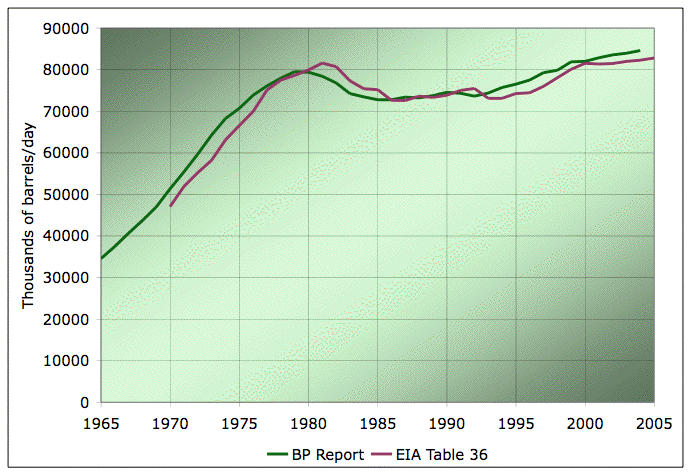
Refinery capacity 1965-2005 by two different estimates. Click to enlarge. Sources: BP Statistical Review of World Energy 2005, and EIA Crude Oil Distillation Capacity (Table 36).
Before we compare capacity to production, I would just like you to note how rapidly capacity grow in the late sixties and seventies. I would also draw your attention to the difference in slope between the late nineties, and the anemic climb of the last few years. We will return to these points in a few graphs. First though, how much of this capacity was being utilized?
It turns out not to be easy to compare EIA production numbers with their refinery capacity, so I stuck to the BP numbers for this next bit. Here's a graph showing how much of refinery capacity each year was actually taken up with production.
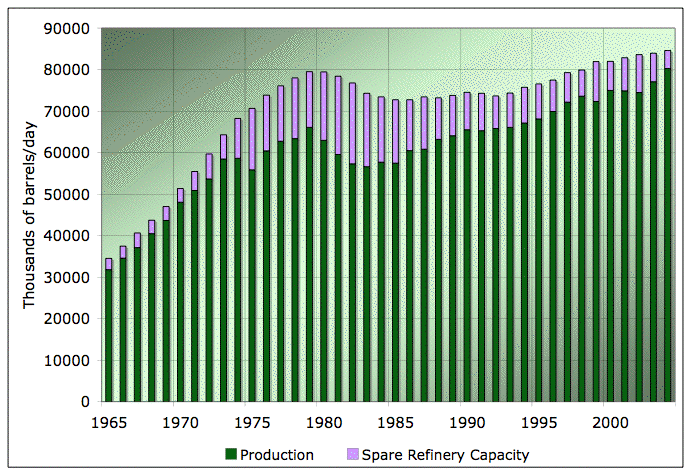
Refinery production and spare capacity 1965-2004. Click to enlarge. Source: BP Statistical Review of World Energy 2005.
We can see that things are starting to get a bit tight at the end there. However, if we look at the ratio of production as a proportion of refinery capacity, we see that it's no tighter in recent years than it was in the 1960s, when neither oil nor gasoline were particularly expensive.
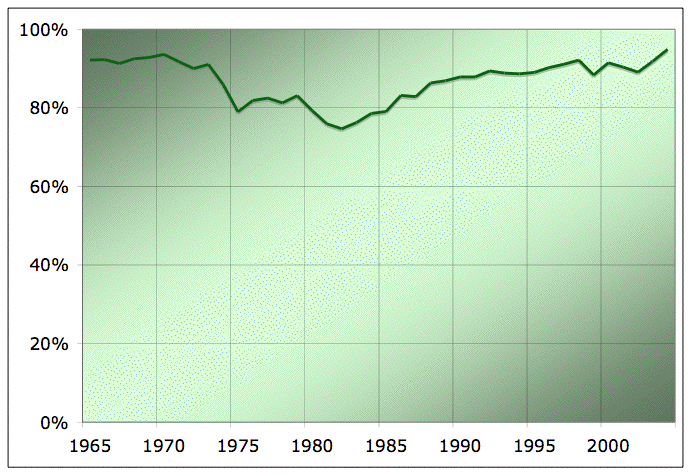
Refinery utilization 1965-2004. Click to enlarge. Source: BP Statistical Review of World Energy 2005.
So we might wonder why the big fuss now? To me, the most revealing graph is this one. This shows the year-on-year growth rate in refinery capacity.

Year-on-year change in refinery capacity 1965-2005 by two different estimates. Click to enlarge. Sources: BP Statistical Review of World Energy 2005, and EIA Crude Oil Distillation Capacity (Table 36).
Points to note:
- In the late sixties and seventies, we knew how to grow global refinery capacity by 6%-10% annually.
- As recently as the late nineties, we were growing global refinery capacity at 2% a year.
- On several occasions, we have increased the growth rate in refinery capacity by one or two percentage points within the space of a year or two. Eg in the late eighties, and again around 1993-1994.
- The only period of near-constant very slow, nay positively anemic, only 1/2%, growth in refinery capacity is the period 2001-2004.
- If we had grown refinery capacity at 1%-2% from 2002 on, there would have been no problem with refinery capacity. The problem was not just that demand grew, it was also that refinery capacity growth was very minimal during that period.
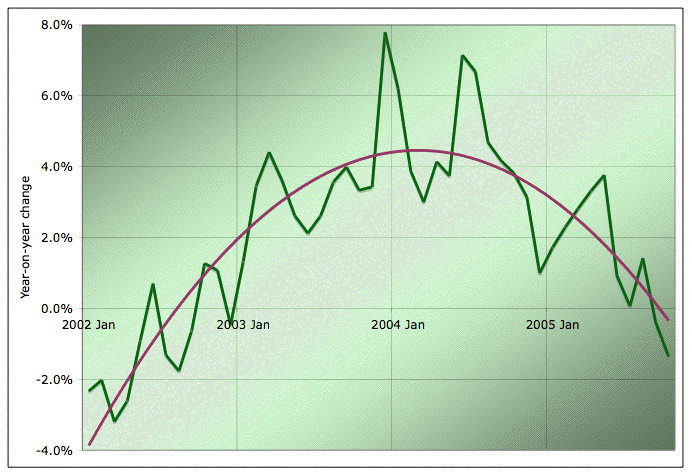
Year-on-year change in monthly EIA oil production Jan 2002-October 2005. The dark green line is the data, and the plum curve is a quadratic fit to the data to illustrate the smooth trend. Click to enlarge. Source: EIA.
So demand growth certainly became respectable -- getting up to about 4% in the smoothed trend -- but nothing out of the historical norm, and generally inline with GDP growth in a healthy economic recovery. Given all this, I cannot believe that we just couldn't increase refining capacity in time to avoid the bottleneck this year. On the historical record, we certainly should have been able to get it up to 2% annually, or even a little better, by now, and that would have been enough to avoid the bottleneck. No, it's not that we couldn't, it's that we didn't. We chose not to.
I can think of only two reasons why we might not have chosen to increase refinery capacity in the way that we obviously could. One is a secret refining cartel. The other is peak oil. I think Calculated Risk made the key argument back in the summer. If the problem was just a refinery cartel, crude oil, or at the very least heavy grades of crude oil, would be selling for $10/barrel. It's not - even the heavy stuff is $50/barrel. That implies there's very little of it to spare, not that there's quite a bit but it's not making it through the refining cartel.
What it looks to me like is the refinery market, explicitly or implicitly, understands that ramping up to compete for market share on CERA's 100mbpd+ of production in the near future would be a very dumb business move. Instead, it looks like they are inching their capacity up in the most gingerly manner possible. They're acting like their big fear is getting caught with too much capacity.
So I call bullshit on this refinery explanation.
Anybody got any other ideas for why this plateau might have happened besides imminent peak oil?




I really do think we are presently at Peak Oil, and this may be reflected in the refinery market where PO has been anticipated by not expanding capacity.
If the above is true, your analysis raises another important question. How long will we be able to maintain the plateau, especially in the light of heavier crude entering the market?
The spread between light and heavy oils has been growing though. While I think this is primarily because of decreases in available light sweet crudes, refinery configuration and capacity do play a complementary role.
These factors are better explained by measures of complexity and conversion, which refer to the ability of a given facility to produce valuable products. Complexity describes the stages of refining that occur after distillation, primarily cracking. These stages are capital intense, actually transform the molecular structure of crude and significantly alter the output of a facility.
If you were to measure the amount of gasoline produced and/or the dollar value of investment in the sector, you would get a completely different result. It is inaccurate to claim that refinery development ground to a stop in the 1990s.
The main reasons why new capacity did not come on line in the recent past are:
- Adequate crude intake capacity
- Ability to produce more product from other investments in the facility
- Regulations that made new facility development difficult, and most importantly,
- Refining was not a profitable industry and did not proivide acceptable returns on investment.
I have been in discussions with bankers and refining executives and seen huge amounts of analysis. If fear peak oil is a signficant factor limiting development, it is the world's best kept secret. Additionally, there several huge new investments in additional refining capacity taking place in India and China, partially funded through int'l investment. Surely the same logic has to apply there.It do think fear of peak oil could be an issue in the future, but see little evidence it has in the past.
Bangchak Petroleum is a simple refinery in Thailand that currently consist of distillation and some basic postdistillation treatment (incl. noncatalytic cracking). This configuration is a standard simple refinery like that found in the US in the past.
The plan to invest $250 million to become a complex refinery. There will be no increase in "capacity", but the new facility will produce much more valuable product (gasoline and diesel) and much less low value product (fuel oil).
This is a very good example of how the modern refining sector is investing and developing. The presentation is fairly clear and provides a great insight into why refining is not as clear as it appears.
If you don't want a lot of (mostly useful) background, skip to slide 25 which describes the upgrade calling it a Product Quality Improvement Project.
http://www.bangchak.co.th/download/analystMeeting15_analystMeeting%2002-12-05.pdf
From my admittedly ignorant perspective, I find it hard to swallow that refineries were not already pretty good at making diesel and gasoline. What kinds of throughput improvements are possible for these outputs? And if the investments are to make other more profitable but lower volume distillates, then does it really matter?
Diesel and heating oil are basically the same until the very end of the refining proces where they are treated differently. Fuel oil is a far lower quality product and is the only significant output that is worth less than crude (see Bangchak slide #12).
A complex refinery does produce a lot more gasoline and diesel from the same barrel of oil. Slide 25 of the Bangchak presentation shows that the refinery currently produces 37% fuel oil, 37% diesel and 15% gasoline. The addition of a $250 -350 million dollar hydrocracker and other equipment changes this significantly. Afterwards it would produce 9% fuel oil, 52% diesel and 25% gasoline from roughly the same crude input.
Refineries have always been good at making gasoline and diesel, they just made less of it from the same input
According to the American Petroleum Association, the typical US refiner produced the following products from a typical barrel of oil.
Distillate: 9.7 gallons
Kerosene-type jet fuel: 4.3
Fuel oil: 2.0
Liquefied gases: 1.9
Still gas: 1.9
Coke: 1.9
Asphalt: 1.4
Petrochemical feedstock: 1.1
Lubricants: 0.5
Kerosene: 0.2
Other: 0.4
"...the refinery currently produces 37% fuel oil, 37% diesel and 15% gasoline." should read 31% fuel oil, not 37%.
1 It is true that no US refineries have been built in 25 years, but this is very misleading - US refinery output, measured in barrels input, has increased around 30% in the period, albeit almost nil since 2000.
2 Refinery profit is dependent on cost of crude less price of product. If crude is rising faster than product prices, as has been true for most of the period from 1998, refinery profits are declining, reducing interest in new investments. (European supplies of product post K/R has naturally cut product prices and refinery profits.) The only company significantly expanding capacity in the US is Valero, which buys up old, antiquated refineries, adds substantial new equipment designed to handle cheap sour/heavy crudes, and ends up with higher output. So, most integrated oils are not interested in expanding because their profits are anemic, but Valero is happily exploiting its niche. Eventually, if refinery capacity is a true bottleneck, crude stocks will continue to rise (as they have been for the last year) while product prices rise, increasing refinery profits and renewing interest in expansion. OTOH, OPEC may defend $55 NYMEX, restricting crude to match refinery capacity.
I grew up in Newfoundland, Canada, and we were very aware of the status of the "Come By Chance" oil refinery, completed in 1974/1975, and then mothballed after about a year of unprofitable operation. It was started up again in 1987 and is fully operational now, but anybody aware of the history would be very reluctant to build a new refinery without being certain we won't get a repeat.
So the particular reason for the decline in refinery capacity additions in the last few years could be expectation of near-term oil price spikes; given that the recent flatness (2001-2004) is coincident with the Bush administration's tenure, maybe oil industry executives knew to expect something... But we wouldn't want to get into conspiracy theories...
For many years after, it was easier an more effective to add capacity further along the process than distillation, this is called debottlenecking. For this reason there have been no greenfield projects in the US. I understand that most opportunities have been exhausted.
But there has been a lot of capital invested in refining and the current infrastructure is not the same as 30 years ago. Demand growth has been for highly refined products such as gasoline, diesel, jet fuel and heating oil. This has been met by additions of crackers and other equipment that create more of these products from the same distillation capacity.
A new era in gas storage is dawning in 2006. The passage of the Energy Act of 2005 has provided FERC with broad new powers to drive storage expansion. They have responded by proposing new rules for market-rates for interstate gas storage to spur the development of storage capacity. Hurricanes Katrina and Wilma also demonstrated the value of gas storage facilities, and have caused many players in the gas market to step up their efforts to develop or acquire more storage capacity. High gas prices, increasing volatility, and increasing liquidity of gas markets have increased the intrinsic value of storage facilities to both active market participants and investors, driving an unprecedented round of acquisition and aggregation plays. Likewise, the introduction of new LNG and pipeline sources is likely to change the potential value of existing assets and drive the development of new storage facilities. Gas storage operators, pipeline operators, gas customers, and storage investors must examine the changes in the regulatory and market landscapes to form effective strategies to profit from opportunities in 2006 and beyond.
It seems that the natural gas industry is not running scared to make investments because of potential supply constraints.
The general thrust of the argument about (non peak oil) refining capacity is this:
Margins were very bad in the 80s & 90s, therefore no capacity was added. In fact in the USA around 0.9mbpd was closed down.
The oil industry/markets were complacent about demand growth.
Complex refineries are far less than simple refineries in number; hence discounted OPEC heavy/sour crudes.
Now a lot of refineries are being built in the middle east, nigeria, indonesia and china to refine product.
In addition Valero, Conoco & others (i dont have my notes!) are building additional capacity in the USA and europe in existing refinery complexes.
The catch up will come with the next recession, by 2010 when some years of slow demand will allow complex refineries to be built to handle heavier grades.
That's the argument, i'm not saying its mine so dont flame me!!
Here's a recent piece I did: Refinery capacity to test crude price in 2006 http://www.resourceinvestor.com/pebble.asp?relid=15460
all the best
adam
If there is problem with refinery capacity,then oil will be cheap ( who needs it if it cannot be refined ) and gazoline expensive. We have seen this situation after harricanes. Extra oil from SPR was not sold, becuase refineries were unable to process it. As result gazoline was at $3 per gallon, while oil was at $65, normally for gozoline to be at $3, oil should be at least $85 per barrel.
There is lack of refineries for heavy crude and we see the it is sold at discount ( $10 to $13 per barrel discount for heavy crude ). Once new refineries of heavy crude is build, then the price of heavy crude will go up, there will be more demand for it.
Basically if gasoline is $3 there is a need to get more crude through the complex to lower the price.
That drives up crude prices, that is caused by the `bottleneck` and is analagous to the discounted heavy crude no one wants...
If there were lots of complex refineries it could go either way, too far and prices would fall (spare capacity) and too little and the same problem remains...
Adam,
I believe your argument is unsound, and the problem with it can be illustrated by the extreme case. Suppose there is hypothetical disaster that removes all petroleum product refineries except one on the U.S. Gulf Coast, whose entire capacity can be satisfied from current Gulf of Mexico production. Would not the world gasoline price be astronomical and would not Saudi Arabian crude oil for export would be worthless?
Yes like i said it does sound a bit odd. But if the case arose as you put it the world would be screaming for gasoline and you need crude to make it. But i think your case is a bit extreme to make a really definitive prediction.
The prices of nat gas, crude, gasoline, heating oil and even emissions credits in the EU tend to drag each other around quite a bit.
The markets see that simple (light sweet) refineries can't cope (if the price of gasoline is high) so this forces up the price of light crudes. At the same time, analagously, heavy crude is sold cheap because there are not enough refineries to put it through the system to make the products the market wants.
I'm not putting it forward as my argument btw, thats just the way the market reacts.
If your case arose it would be very very extreme, you could see all sorts of trades going on like huge longs and shorts on products and on their crack spreads.
At the moment that's kind of the way the market gets it, why refinery bottlenecks affect price, why they are building so many new refineries now (in the m/east)..
Right. A lot of this has already happened with the driver in the past being demand for products rather than need to process lower quality crudes. It may be hard to distinguish between the two investments. The most useful statistics may be refinery capacity, capacity utilization, complexity and conversion by country. Complexity and conversion are measures of the ability of a refinery to produce better products from worse inputs - creating higher refining margins.
I think this is the right question and you would find that in the US much of the potential upgrading has been done. The US does not have any major simple refineries and has been doing more sophisticated debottlenecking. I think there is more low hanging fruit in other countries.
http://www.gasandoil.com/goc/news/ntn44964.htm
http://wyden.senate.gov/leg_issues/reports/wyden_oil_report.pdf
That last bit rings true. Here's the industry spokesman in September 05:
http://www.thehill.com/thehill/export/TheHill/Business/091405.html
So that's another idea: The industry is waiting for a government handout.
Another view:
http://www.freenewmexican.com/news/2356.html
According to Wyden's newer 2004 Report: No new refineries have been built in this country since 1976. The number of refineries dropped from 282 to 153 between 1977 and 2002. Refining capacity has increased 2.4% [by expanding existing refineries] while gasoline demand has lunged ahead 27%, over this time period. Internal documents from Chevron and Texaco in the mid-1990's said that they needed to decrease gasoline supplies and refining capacity in order to increase profit margins.
Whether you examine the BP data as Stuart has, or the EIA data (Wyden's numbers are from the EIA, considering the US only), the general glut in refinining capacity during the late 70's and 80's is evident. it was this spare capacity that the major refiners wished to clamp down on, purely for profit considerations.
Dubai (heavy, sour) and WTI (light, sweet)
Here's his observation. Now, as CalculatedRisk argued where we have this situation--
Raw Material --->> bottleneck --->> Finished Good
raising the production of raw material (heavy, sour crude) in this case could only lower its price because demand is constant--it is set by the bottleneck. The only way for heavy, sour prices to go up is to up the refinery capacity for these grades of oil and loosen the bottleneck.
Which is why Saudi Arabia is now in the refining business. Interestingly, these investments are in Asia. From OPEC tries to compete with Russia over China's oil needs: Saudi Arabia is also ramping up to build refining capacity to process their own output. (Sorry, no link on this). When the beloved and esteemed Ali Al-Naimi blames price hikes on refinery capacity, we can translate that as "we want to get as much money for our heavy, sour crude as you other guys are getting for that good light sweet stuff".
As for the US, from Exxon, BP Rebuff Pleas to Boost Exploration as Oil Demand Soars I have no way of evaluating any of these statements but confusion reigns. Gratuitous Photo Opportunity.
Deep in thought...
In my mind, one is left with only two scenarios that make sense of the price and capacity history: 1) OPEC is getting better and more disciplined at price support on crude and decided to raise the price while claiming they weren't. 2) OPEC can't readily pump much more because they it's getting harder to overcome depletion in their fields, and no-one else can increase production quickly enough either.
I don't find 1) very plausible - what has changed to suddenly make OPEC more disciplined? 2) says imminent peak oil.
However, u must admit that the data ends for the most part in Dec 2004. While u would like to claim that capacity was not an issue (wrt supply) in latter 2005, we will not be able to see it 'til the new data is out. But really, we know already what it will show. We hit the 100% barrier.
Your studies this week by extrapolation illustrates that supply was stymied by capacity/production restrictions in the GoM and reduced exports from Iraq. It is not a case of looking at the gloas half-full instead of half-empty. There was a squeeze play this summer and i have no doubt that the growth rate in extraction will resume at a 1.25-mbd rate over the next five years. Your work will also help us look at price movement as we go thru this period. But capacity utilization is only one component. OECD stocks are important as well. And we have been mired in the 52-54 day reserve channel for much too long. J-I-T (just-in-time) does not work well in the oil sector!
My Oil Depletion Scenario modelers continued their trend in 2005. The optimists came down and the peakists revised up. I expect this convergance of Outlooks to continue thru the decade. I will start to worry when the Campbell/Laherrere/Kopplaar start to revise down to meet the TOD negativism. They will be the canary in the mine ... not price ... not seasonal extraction downturns.
http://TrendLines.ca/economic.htm
For Laherrere (ASPO moderate) and CERA, both using the same industry data source, the convergence may well be already there.
Laherrere (writing in 2003):
"If the present economic recession is protracted, demand could stay level for the next ten years, giving a bumpy production plateau of around 80 Mb/d. If supply is constrained by demand in this way, then the decline need not start before 2020."
CERA (writing in December 2005):
"The question of a worldwide peak in oil production continues to stimulate debate. Our outlook shows no evidence of a peak in worldwide oil production before 2020."
I agree with you that refinery capacity was likely signifantly tighter during 2005, especially with the hurricane outage. My point is not that refinery capacity wasn't an issue, it's that it needn't have been an issue if efforts had been made to increase it that are entirely unremarkable by historical standards. They weren't made because it didn't (and still doesn't) look like a good business proposition to expand refinery capacity aggressively in the US/Europe because input prices are too high and volatile (and output prices are affecting demand). Thus the ROI on the deployed capital is not good enough to justify more effort than has been made (Dave has some nice quotes on this in one of his comments). That fact has to be explained by restrictions in crude supply, not restrictions in refinery capacity.
To the lay reader, there is a huge emotional difference between "we're probably peaking now" and "we'll probably peak in 2015". In the latter case, you might quit worrying about it, and check back in on the blogs around 2013.
OK, I done that.
Re: "1) OPEC is getting better and more disciplined at price support on crude and decided to raise the price while claiming they weren't. 2) OPEC can't readily pump much more because they it's getting harder to overcome depletion in their fields, and no-one else can increase production quickly enough either."
Yet as I pointed out, OPEC is getting more heavily into the refining business. Why would that be if your #2 scenario is correct? They're making some heavy investments so they have heard "the market signal for 'we have a big problem with refinery capacity: build more'". Especially in Asia which is where most of the demand growth is. The beloved & esteemed Ali Al-Naimi is, after all is said and done, a businessman. He can't do business selling heavy crude to the US or Europe so he has decided to do business with China where ironically he has more leverage. From The Emirates Economist After you're done making some $$, could you explain your view of this to me? Why would the US/Europe and OPEC be so wildly at variance on this issue? Please, if anyone else has some thoughts on this, please speak up.
As far as the Saudis - how can they lose? When the world is very thirsty because there isn't quite enough oil and they have a big chunk of the remaining resource (even if it's not as big a chunk as they claim, it's still big), they stand to make the most profit by selling us refined products instead of crude and gouging us on the refinery margin as well as on the crude itself. There's no reason they have to send us any crude - they can just send us products, wait for our refineries to go out of business, and then clean up. That's what I'd do if I were a ruthless business-person in charge of Saudi oil.
You seem to place a lot of faith in I am familiar with your view here. If you are right about this, then US/European refining capacity will be adequate and it will be OPEC--who are increasing their own refining capacity--meeting more and more of our refined products demand. This has the obvious consequence of making us more dependent on them than ever before. On the other hand, if the US expands its own refining capacity, it is more capable of importing and processing oil from a larger, more diverse set of sources (like West Africa). This would seem to be a desirable goal that makes us much more secure--it is axiomatic not to put all your eggs in one basket.
So, IMO, the picure you paint points toward a shit-storm crisis of huge proportions as we go forward--especially in light of the geopolitical volatility of the Middle East. Now surely some of the big financial investors in the Western World might have the foresight to acknowledge and take steps to mitigate this problem?
In your view, apparently not.
So, given the security issues I spoke of above and the view that US demand is fairly inelastic, I would say that the shit-storm I spoke of has a middle-range probability in the next few years in light of the reluctance and inability of the US to expand refinery capacity and increase demand elasticity.
- Are people already getting adequate price signals to change behavior?
- How much time is left before supply constraints force the small (3-5%) consumption drop?
I think that 1) is starting to happen. As long as the time frame for 2) is 5-10 years, I do see the ability to adjust.The reason I think this is because the US has a huge amount of energy consumption that is basically a luxury. It could be shaved off without disruptive economic impacts (on the economy as a whole). If oil prices stay high, these prices willgradually be passed on all products that depend on oil including personal trabsportation, home heating, and purchase of goods that have high energy inputs (in production and/or transportation).
I am not saying this will be magic, easy or guaranteed - or that some people won't get hurt. I do think that the US economy can grow despite diminishing oil supplies if the adjustment period is smooth.
In your blow-up of production growth in the last 3 years, growth is negative by the end of 2005. I find this interesting. We don't see any sustained increase in demand over the past few years, another reason why refinery majors would be VERY reluctant to increase capacity, to ensure their profit margins stay high (as they have done for 20 years) while capacity remains tight . Peak oil is not necessary to explain this because it's been going on for decades.
cited by Stuart: is there some reason why cartel
behavior by the petroleum industry as a whole is
inconceivable, as opposed to just refiners? If not,
a peak (inevitable sometime for purely geologic reasons) could be engineered to occur at the time and
in the manner most profitable for the industry and most
politically oppertune for governments with influence
over the industry. Is that sort of coordination
impossible?
Doesn't all this imply some, if not a conspiracy, but rather a tacit agreement among all those in a position to invest in refinery infrastructure (at least in the West) that peak oil risks do not justify such investments? As Stuart says, all these investors tend to talk to each other and are obviously aware of the forecasts made by Simmons, Groppe and others. On the other hand, there are optimistic assertions made by CERA, the USGS, Lynch, IEA et. al. There's surely a wide diversity of views on this among the big investors.
I for one simply don't believe that peak oil is taken seriously enough by everyone in the world of big finance to make these kinds of claims.
The real question is why did oil prices get so high this past year, and in general why have they been on such a steady upward trend since hitting a low of about $10 (in today's money) in the late 90s? Well, I don't know! I have certainly heard a number of opinions about it, but IMO most explanations offered for financial trends are not very convincing and credible.
However I would suggest that the price rise this past year should be seen in the context of the steady price rises in previous years. In other words, it is the continuation of a trend, not something new. So it seems logical to me that the cause of this past year's high prices is probably closely related to the forces which have caused the price to rise over the previous five year period.
Now, if this cause is in fact as Stuart suggests "peak oil", a physical limit on how much oil can be produced, then that means that the first stirrings of peak oil were felt five years ago. I'm not sure that is a plausible explanation though. Few people invoke peak oil to explain the early stages of the climb from $10 oil. We could argue that the beginning of the price rise had one cause and only the recent increases were due to peak oil, but Occam's Razor somewhat discourages such multiplication.
The alternative explanation I have seen is that the low prices of the 90s, after the price collapses of the 80s, made the industry risk-averse and so there was under-investment in development projects in the 90s. Since there is such a long lead time between the initiation of a project and when it reaches full production, the result was an "oil drought" which we are still experiencing today. This explanation predicts that recent high prices will motivate a surge of new projects and that there will be a glut of oil in the near future.
That's the great thing about explanations, there are always so many of them that we are free to choose the one that best fits our predispositions and prejudices.
It's conceivable that several years ago, there was somewhat "secret" and closely held knowledge about peak oil among insiders who were taking positions in the market in advance of greater public awareness of the issue. Then you might see something like this, as their investments, small at first, gradually began to make an impact. Prices would begin to rise even without widespread understanding of what is driving them. Then eventually people would clue in to what is happening and the effects would grow.
As I say, it is a conceivable story but I'm not sure it is a persuasive one. It requires something of a conspiracy among "insiders" and a degree of successful secrecy that is not often found in the world. It's also difficult to come up with a specific scenario for the time frame over which this happened. I'm not sure there is any historical precedent for an investment conspiracy based on private knowledge that managed to keep its advantageous secret over a period of years.
Considering Halfin's comment and this response, I feel like I'm entering an alternative universe. Halfin says, responsibly in my view, that a "conspiracy" is improbable. Thank God.
Re: "I have a different, but equally subjective, impression. My sense is that mentions of peak oil in the business and mainstream media have been building for several years".
Of course. This is because prices are rising rapidly year-on-year and it's become obvious that supply is barely keeping up with demand. That's it, that's the whole ball of wax. That's why there's more publicity. But to even talk about a conspiracy and make a serious reply to that--even if we are dismissing it--makes the whole serious discussion about Peak Oil vulnerable to all sorts of crazies that have latched on to the idea. I'm sorry, but I'd have to say, Stuart, that your post opened this Pandora's Box and I'm trying very hard to close it.
A search on ABI Inform database. ABI/INFORM Global indexes and abstracts over 1,400 business and economics journals, magazines, and trade publications. In addition, it provides the full text and/or page images of the articles from about half of these periodicals.
Baseline: Number of articles mentioning the word "oil" in citation or article text calendar year 2005: 31,642
Number of articles mentioning either "peak oil" or "oil depletion" in citation or article text for calendar year:
2005 74 (out of 31,642 mentioning "oil")
2004 39
2003 24
2002 15
2001 19
2000 14
1999 12
1998 10
1997 12
1996 9
1995 7
1994 15
1993 6
1992 8
1991 1
1990 0
So mentions of peak oil are up dramatically--but still trivially small in the absolute, when examining business, academic, and trade journals. I'm sure the numbers would be much higher in mainstream media, but probably with similar trends.
Of course if belief in a near-term peak was false, what would happen is that suppliers would be delighted and jump in to try and capture market share while the prices were so excellent. This negative feedback loop on prices would depress them again after a while. It is the fact that they have not been able to do so to good effect that leaves the hypothesis intact.
$70 oil in March looks a sound bet.
1 Prices collapsed in 1998 because OPEC squabbled and over-produced.
2 Prices recovered in 2000 because OPEC settled the squabble and reduced production.
3 Prices declined in 2001 because of the dot.com crash.
4 The surprising new demand from China/India, not expected by any market participants, let to ever higher demand and prices through mid-2005 as OPEC struggled to meet demand, ultimately producing all they could, save only some over-priced heavy sour from Saudi.
5 K/R raised prices further, to the extent that US gasoline demand declined for the first time since around 1980.
6 Reduced demand from high prices lead to rising stocks of both crude and product, lowering prices. Lower prices then lead to an immediate increase in demand, but crude stocks continued to rise.
7 Rising stocks is a red flag to OPEC, and reminded them of their raison d'etre. They are particularly alarmed because prices were falling in winter, even before the onset of the spring shoulder season. Accordingly, and confident that $60 poses no harm to their more important customers, they seem likely to reduce output following their end-Jan meeting, no doubt pleasing peak oilers as well as big and small oil alike.
None of this, by itself, means peak oil is, or is not, around the corner. On balance, the evidence seems to indicate it may be coming soon, but I can understand fears of oil CEO's that investments today, at high prices, will lose them money later. Executives of mid and small-sized companies, in particular, no coubt remember how they, or others, lost their jobs in the 1998 crash. Nearly all of these executives are nearing retirement - no time to risk all on new ventures.
Sales of existing properties by a large company to a smaller one means nothing by itself - this is traditional; as properties require ever higher amounts of labor to develop the last dregs, they are routinely passed to those with lower costs. There is no doubt that costs are rising - perhaps the large companies just need time to convince themselves the high prices are here to stay. OPEC might help in this matter. Meanwhile, buying back stock keeps stock holders happy and usefully boosts executive options.
Here's the YoY growth rates. Definitely China had a big 04, but not that much out of their range of variability, and India has had a rather lower growth the last few years.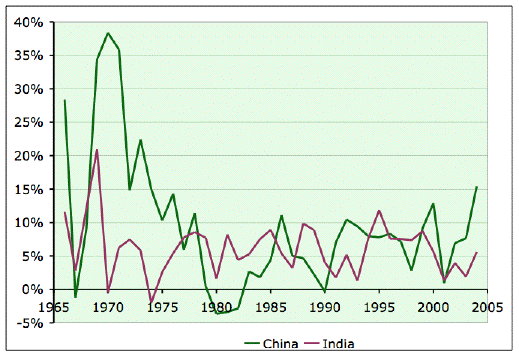
Overall world demand growth was 4.2% year on year in 2004 - certainly strong, but by no means off the scale of recent historical exerience.
And, the larger growth rates earlier, during the seventies, came on a very small base. The affect China's growing economy is having, whether on resource imports or competition, affects the rest of the world much more now for the same reason. 10%/year growth was not much in the eighties, but after a couple of decades go by, the elephant is no longer a baby. Imagine another fifty years... no worries, we'll all be out of oil by then.
Really? You couldn't think of any other explanation?
The economists will argue that obviously there is a fear on the part of the refining industry that market prices for refined oil products will collapse again, as they did before; that fear is the obvious explanation for the reluctance to invest in new refineries. It's the exact opposite of a fear of Peak Oil.
I don't necessarily subscibe to that argument. But it is the obvious argument, and to ignore it by saying it didn't occur to you is not, I believe, a good way to engage Peak Oil doubters into a meaningful discussion. Rather, it will make it seem as if your conclusions are formulated upon heavily biased premises.
There is no enthusiasm for increasing capacity. What would it take to make them enthused? Higher ROI. What would make the ROI higher? A larger spread between crude and products. In short, the lack of refinery capacity growth is an effect of the high cost of crude (at least heavy grades), not a cause of it.
Do you have the data to see what is happening to total product production as the world's crude moves toward heavy/sour? If peak crude output to date is May 05, isn't it likely that product volumes peak to date is sometime earlier? Product flows switch around based on price, so maybe gasoline/distillate combination?
Yes, there will always be a balance - as far as refiners see it - with capacity.
Most new refineries are being built in the m/east but also in Indonesia, China (with aramco, exxon and others), Nigeria. In m/e Qatar, Saudi, Kuwait, UAE all expanding, and more countries too. Iran desperately needs refining capacity - it impoirts $7bn a year of refined product. Also many of these nations have a rising young, population.
But big new expansions are online in existing US refineries, Valero announced one recently if i remember...
As for the media - its very different to just 3 or 4 years ago...as regards oil and energy reporting etc...but it could be much better...